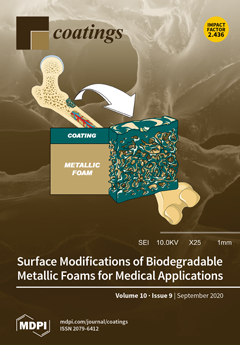In recent years, the field of nanoporous metals has undergone accelerated developments as these materials possess high specific surface areas, well-defined pore sizes, functional sites, and a wide range of functional properties. Nanoporous gold (NPG) is, surely, the most attractive system in the
[...] Read more.
In recent years, the field of nanoporous metals has undergone accelerated developments as these materials possess high specific surface areas, well-defined pore sizes, functional sites, and a wide range of functional properties. Nanoporous gold (NPG) is, surely, the most attractive system in the class of nanoporous metals: it combines several desired characteristics as occurrence of surface plasmon resonances, enormous surface area, electrochemical activity, biocompatibility, in addition to feasibility in preparation. All these properties concur in the exploitatiton of NPG as an efficient and versatile sensong platform. In this regard, NPG-based sensors have shown exceptional sensitivity and selectivity to a wide range of analytes ranging from molecules to biomolecules (and until the single molecule detection) and the enormous surface/volume ratio was shown to be crucial in determining these performances. Thanks to these characteristics, NPG-based sensors are finding applications in medical, biological, and safety fields so as in medical diagnostics and monitoring processes. So, a rapidly growing literature is currently investigating the properties of NPG systems toward the detection of a multitude of classes of analytes highlighting strengths and limits. Due to the extension, complexity, and importance of this research field, in the present review we attempt, starting from the discussion of specific cases, to focus our attention on the basic properties of NPG in connection to the main sensing applications, i.e., surface enhanced Raman spectroscopy-based and electrochemical-based sensing. Owing to the nano-sized pore channels and Au ligaments, which are much smaller than the wavelength of visible light (400–700 nm), surface plasmon resonances of NPG can be effectively excited by visible light and presents unique features compared with other nanostructured metals, such as nanoparticles, nanorods, and nanowires. This characteristics leads to optical sensors exploiting NPG through unique surface plasmon resonance properties that can be monitored by UV-Vis, Raman, or fluorescence spectroscopy. On the other hand, the catalytic properties of NPG are exploited electrochemical sensors are on the electrical signal produced by a specific analyte adsorbed of the NPG surface. In this regard, the enourmous NPG surface area is crucial in determining the sensitivity enhancement. Due to the extension, complexity, and importance of the NPG-based sensing field, in the present review we attempt, starting from the discussion of specific cases, to focus our attention on the basic properties of NPG in connection to the main sensing applications, i.e., surface enhanced Raman spectroscopy-based and electrochemical-based sensing. Starting from the discussion of the basic morphological/structural characteristics of NPG as obtained during the fabrication step and post-fabrication processes, the review aims to a comprehensive schematization of the main classes of sensing applications highlighting the basic involved physico-chemical properties and mechanisms. In each discussed specific example, the main involved parameters and processes governing the sensing mechanism are elucidated. In this way, the review aims at establishing a general framework connecting the processes parameters to the characteristics (pore size, etc.) of the NPG. Some examples are discussed concerning surface plasmon enhanced Uv-Vis, Raman, fluorescence spectroscopy in order to realize efficient NPG-based optical sesnors: in this regard, the underlaying connections between NPG structural/morphological properties and the optical response and, hence, the optical-based sensing performances are described and analyzed. Some other examples are discussed concerning the exploitation of the electrochemical characteristics of NPG for ultra-high sensitivity detection of analytes: in this regard, the key parameters determing the NPG activity and selectivity selectivity toward a variety of reactants are discussed, as high surface-to-volume ratio and the low coordination of surface atoms. In addition to the use of standard NPG films and leafs as sensing platforms, also the role of hybrid NPG-based nanocomposites and of nanoporous Au nanostructures is discussed due to the additional increase of the electrocatalytic acticvity and of exposed surface area resulting in the possible further sensitivity increase.
Full article





